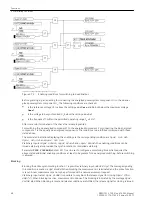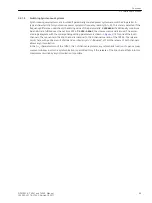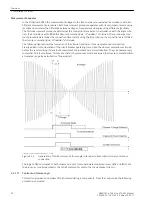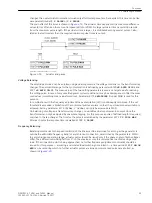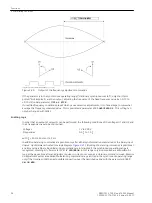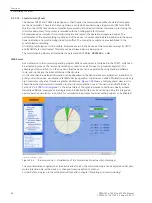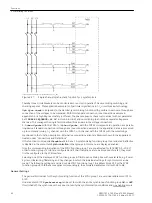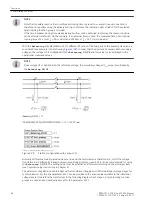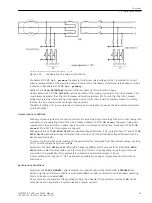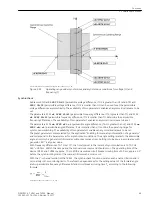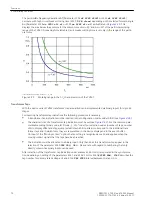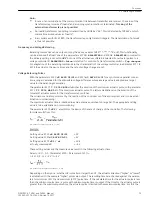
[ve6-anschluss-3-einkanalige-synccheck-030205-kn, 1, en_GB]
Figure 2-27
Single-channel synchrocheck function for 3 synchronizers
Thereby three circuit breakers can be monitored more or less in parallel. This saves wiring switching and
checking expense. This application example is of particular significance in 1
1
/
2
circuit breaker technology.
3ph Sync check
corresponds to the classical synchronizing function with possible in each case three-phase
connection of the voltages to be compared. With this standard connection (see connection example in
appendix A.3) a high degree of safety is offered. The phase sequence check is also active (with set parameter
6x13
PHASE SEQUENCE
=
L1 L2 L3
or
L1 L3 L2
) and on switching to an idle bus several voltages are
scanned. This manages the single fault condition (broken wire in the voltage connection).
1,5chan.Synchr
with the 7VE61 or
2chan.Synchr.
with the 7VE63 corresponds to operation as a paralle-
ling device. Standard connection is three-phase (see connection example in the appendix), data are processed
up to command issuing 1
1
/
2
channel with the 7VE61, or 2-channel with the 7VE63 with the monitorings
mentioned in the function description. Alternative connection variant are likewise shown in the appendix or
treated under “Connections and Definitions”
If the function is not required
Disabled
is to be set. A synchronizing function group thus rendered ineffective
is disabled in the menu item Synchronization; other groups in this menu are displayed enabled.
Only the corresponding indications of the SYNC Function group 1 are pre-allocated for IEC 60870–5–103. If
other function groups (2 to 8) are configured and if their indications are to be disposed of via IEC, they must
first be configured to the SYS interface.
Selecting one of the displayed SYNC function groups in DIGSI opens a dialog box with several tabs, e.g. Power
System, U Balancing,f Balancing and Tap changer in which the individual settings for synchronism can be
made. The following settings are carried out via SYNC Function group 1 in address block 61. For the SYNC
function groups 2 to 8 the same applies correspondingly, the associated addresses start with 62 to 68.
General Settings
The general limit values for the synchronizing function of the SYNC group 1 are set under addresses 6101 to
6120.
Under address 6101
Synchronizing
can be set to switch the entire synchronous function group
ON
- or
OFF
.
If switched off, the synchronous check does not verify the synchronization conditions and no enabling occurs.
Functions
2.2 Paralleling Functions
62
SIPROTEC 4, 7VE61 and 7VE63, Manual
C53000-G1176-C163-3, Edition 10.2017
Summary of Contents for SIPROTEC 4 7VE61
Page 8: ...8 SIPROTEC 4 7VE61 and 7VE63 Manual C53000 G1176 C163 3 Edition 10 2017 ...
Page 24: ...24 SIPROTEC 4 7VE61 and 7VE63 Manual C53000 G1176 C163 3 Edition 10 2017 ...
Page 142: ...142 SIPROTEC 4 7VE61 and 7VE63 Manual C53000 G1176 C163 3 Edition 10 2017 ...
Page 192: ...192 SIPROTEC 4 7VE61 and 7VE63 Manual C53000 G1176 C163 3 Edition 10 2017 ...
Page 222: ...222 SIPROTEC 4 7VE61 and 7VE63 Manual C53000 G1176 C163 3 Edition 10 2017 ...
Page 230: ...230 SIPROTEC 4 7VE61 and 7VE63 Manual C53000 G1176 C163 3 Edition 10 2017 ...
Page 256: ...256 SIPROTEC 4 7VE61 and 7VE63 Manual C53000 G1176 C163 3 Edition 10 2017 ...
Page 314: ...314 SIPROTEC 4 7VE61 and 7VE63 Manual C53000 G1176 C163 3 Edition 10 2017 ...
Page 316: ...316 SIPROTEC 4 7VE61 and 7VE63 Manual C53000 G1176 C163 3 Edition 10 2017 ...
Page 330: ...330 SIPROTEC 4 7VE61 and 7VE63 Manual C53000 G1176 C163 3 Edition 10 2017 ...

